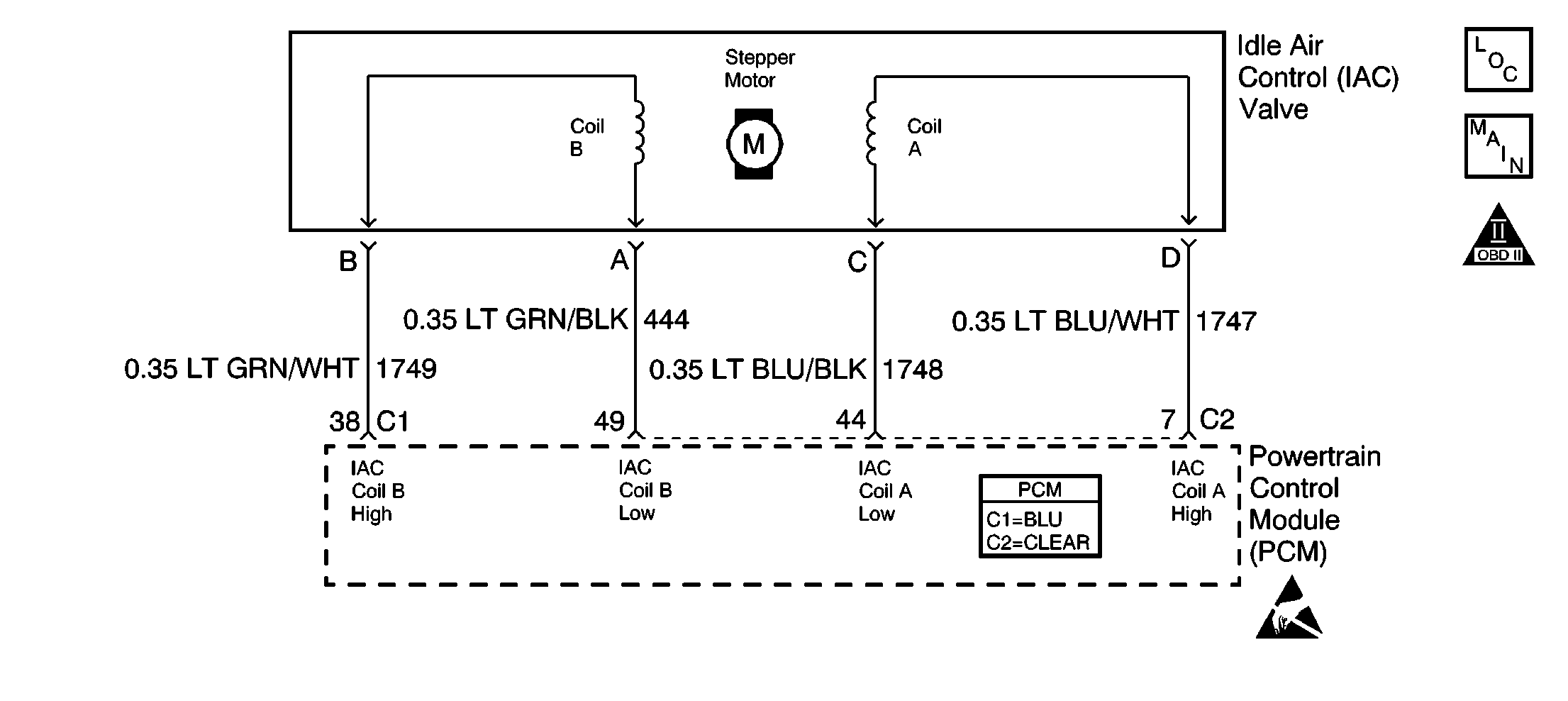
Circuit Description
The powertrain control module (PCM) controls engine idle speed by adjusting the position of the idle air control (IAC) motor pintle. The IAC is a bi-directional motor driven by two coils. The PCM sends pulses to the IAC to extend or retract the IAC pintle into a passage in the throttle body to decrease or increase air flow. The commanded IAC position, displayed in counts, can be monitored on the scan tool. A lower number of counts indicates less commanded airflow, pintle extended. This method allows highly accurate control of idle speed and quick response to changes in engine load. If the PCM detects a condition where too high of an idle speed is present and the PCM is unable to adjust idle speed by decreasing the IAC counts, DTC P0507 will set.
Conditions for Running the DTC
| • | No VSS, TP Sensor, EVAP System, Misfire, IAT Sensor, MAP Sensor, Fuel Trim, Fuel Injector, EGR Pintle Position, ECT Sensor, CKP Sensor, or MAF Sensor DTCs set. |
| • | BARO is more than 65 kPa. |
| • | Engine has been running for at least 60 seconds. |
| • | System voltage is between 9-16 volts. |
| • | Engine coolant temperature is more than 70°C (158°F). |
| • | Vehicle speed is less than 3 mph. |
| • | Intake air temperature is more than -18°C (0°F). |
| • | The throttle is closed. |
Conditions for Setting the DTC
| • | Engine speed is more than 175 RPM higher than Desired Idle. Positive idle speed error more than 175 RPM. |
| • | The above conditions are present for longer than 15 seconds. |
Action Taken When the DTC Sets
| • | The PCM will illuminate the malfunction indicator lamp (MIL) during the second consecutive trip in which the diagnostic test has been run and failed. |
| • | The PCM will store conditions which were present when the DTC set as Freeze Frame/Failure Records data. |
Conditions for Clearing the MIL/DTC
| • | The PCM will turn OFF the malfunction indicator lamp (MIL) during the third consecutive trip in which the diagnostic has run and passed. |
| • | The history DTC will clear after 40 consecutive warm-up cycles have occurred without a malfunction. |
| • | The DTC can be cleared by using a scan tool. |
Diagnostic Aids
Inspect for the following conditions:
| • | Vacuum leak -- Inspect for a condition that causes a vacuum leak, such as disconnected or damaged hoses, leaks at EGR valve and EGR pipe to intake manifold, leaks at throttle body, malfunctioning or incorrectly installed PCV valve, leaks at intake manifold, etc. |
| • | Throttle body -- Inspect for a sticking throttle plate. Also inspect the IAC passage for deposits or objects which will not allow the IAC pintle to fully extend. |
Many situations may lead to an intermittent condition. Perform each inspection or test as directed.
Important: : Remove any debris from the connector surfaces before servicing a component. Inspect the connector gaskets when diagnosing or replacing a component. Ensure that the gaskets are installed correctly. The gaskets prevent contaminate intrusion.
| • | Loose terminal connection |
| - | Use a corresponding mating terminal to test for proper tension. Refer to Testing for Intermittent Conditions and Poor Connections , and to Connector Repairs in Wiring Systems for diagnosis and repair. |
| - | Inspect the harness connectors for backed out terminals, improper mating, broken locks, improperly formed or damaged terminals, and faulty terminal to wire connection. Refer to Testing for Intermittent Conditions and Poor Connections , and to Connector Repairs in Wiring Systems for diagnosis and repair. |
| • | Damaged harness--Inspect the wiring harness for damage. If the harness inspection does not reveal a problem, observe the display on the scan tool while moving connectors and wiring harnesses related to the sensor. A change in the scan tool display may indicate the location of the fault. Refer to Wiring Repairs in Wiring Systems for diagnosis and repair. |
| • | Inspect the powertrain control module (PCM) and the engine grounds for clean and secure connections. Refer to Wiring Repairs in Wiring Systems for diagnosis and repair. |
If the condition is determined to be intermittent, reviewing the Snapshot or Freeze Frame/Failure Records may be useful in determining when the DTC or condition was identified.
Test Description
The numbers below refer to the step numbers on the diagnostic table.
Step | Action | Values | Yes | No | ||||||||
|---|---|---|---|---|---|---|---|---|---|---|---|---|
1 | Did you perform the Powertrain On Board Diagnostic (OBD) System Check? | -- | ||||||||||
2 | Are any other DTCs set? | -- | ||||||||||
3 |
Does Engine Speed vary less than the specified value from each RPM commanded? | 50 RPM | Go to Diagnostic Aids | |||||||||
4 |
Does the node light cycle from red to green, never off? | -- | ||||||||||
5 |
Did you find and correct the condition? | -- | ||||||||||
6 |
Did you find and correct the condition? | -- | ||||||||||
7 |
| -- | ||||||||||
8 | Replace the IAC valve. Refer to Idle Air Control Valve Replacement . Is the action complete? | -- | -- | |||||||||
9 |
Did you find and correct the condition? | -- | ||||||||||
|
Important: : The replacement PCM must be programmed. Replace the PCM. Refer to Powertrain Control Module Replacement/Programming . Is the action complete? | -- | -- | ||||||||||
11 |
Does the Engine Speed vary less than the specified value from each RPM commanded? | 50 RPM | ||||||||||
12 |
Does the DTC reset? | -- | System OK |
